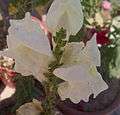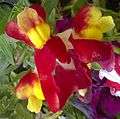Antirrhinum
| Antirrhinum | |
|---|---|
| Antirrhinum majus | |
| Scientific classification | |
| Kingdom: | Plantae |
| Clade: | Angiosperms |
| Clade: | Eudicots |
| Clade: | Asterids |
| Order: | Lamiales |
| Family: | Plantaginaceae |
| Tribe: | Antirrhineae |
| Genus: | Antirrhinum L. |
| Type species | |
| Antirrhinum majus L. | |
| Sections | |
| |
Antirrhinum is a genus of plants commonly known as dragon flowers or snapdragons because of the flowers' fancied resemblance to the face of a dragon that opens and closes its mouth when laterally squeezed. They are native to rocky areas of Europe, the United States, and North Africa.[1]
Description
The genus is morphologically diverse, particularly the New World group (Saerorhinum).[2] The genus is characterized by personate flowers with an inferior gibbous corolla.
Taxonomy
Antirrhinum used to be treated within the family Scrophulariaceae, but studies of DNA sequences have led to its inclusion in a vastly enlarged family Plantaginaceae within the tribe Antirrhineae.
Circumscription
The taxonomy of this genus is complex and not yet fully resolved at present. In particular the exact circumscription of the genus, especially the inclusion of the New World species (Saerorhinum), is contentious.[2] The situation is further complicated by the variety of terms in use for infrageneric ranks, especially of the Old World species, that is Antirrhinum, sensu stricto (e.g. Streptosepalum, Kicksiella, Meonantha).
The USDA Plants Database recognises only two species: A. majus (the garden snapdragon), the only species naturalised in North America, and A. bellidifolium (the lilac snapdragon), now considered to be Anarrhinum bellidifolium (L.) Willd.[3] As of April 2017, The Plant List (Version 1.1) accepts 21 species.[4]
A widely accepted scheme (Thompson 1988) placed 36 species in the genus in three sections. While many botanists accepted this broad circumscription (sensu lato), whose main departure from other classifications was the inclusion of the New World Saerorhinum,[5] others did not, restricting the genus to the Old World. (For a comparison of Thompson with earlier systems, see Oyama and Baum, Table 1.) New species also continue to be discovered (see e.g. Romo et al., 1995).
In 2004 research into the molecular systematics of this group and related species by Oyama and Baum confirmed that the genus sensu lato as described by Thompson is monophyletic, provided that one species (A. cyathiferum) is removed to the separate genus Pseudorontium, and the two species of Mohavea (Mohavea confertiflora and M. breviflora) are included. The species list given here follows these conclusions.[2]
This is the broad circumscription that includes the Old World Misopates and New World Sairocarpus. By contrast the narrow circumscription (sensu stricto) confines the genus to the monophyletic Old World perennial species with a diploid chromosome number of 16, distributed in the Mediterranean basin, approximately 25 species. (Tolety 2011), following the phylogenetic analysis of Vargas et al. (2004) suggesting they are a distinct group. Both Misopates and Sairocarpus are accepted names in The Plant List, and many of the New World species now have Sairocarpus as their accepted name, rather than Antirrhinum. It has been proposed that many of the New World Antirrhinum be now considered under Sairocarpus, in the forthcoming Flora of North America.[6]
Infrageneric subdivision
It is widely agreed that this broad group should be subdivided into three or four subgroups, but the level at which this should be done, and exactly which species should be grouped together, remain unclear. Some authors continue to follow Thompson in using a large genus Antirrhinum, which is then divided into several sections; others treat Thompson's genus as a tribe or subtribe, and divide it into several genera. For a comparison of earlier schemes see Mateu-Andrés and de Paco, Table 1 (2005)[7]
If the broad circumscription is accepted, its three sections as described by Thompson are as follows (two Old World, one New):
- Section Antirrhinum: 19 Old World species of relatively large flowered perennial plants, including the type species Antirrhinum majus, mostly native to the western Mediterranean region with a focus on the Iberian Peninsula. Chromosomes n=8. (3 subsections: Majora, Sicula, Hispanica)
- Section Orontium: two species, also from the Mediterranean. Chromosome number=8. The species in this section, including the section type species Antirrhinum orontium (lesser Snapdragon) are often treated in the genus Misopates.
- Section Saerorhinum: 15 small flowered New World species, mostly annual plants and mostly native to California, though species are found from Oregon to Baja California Sur and as far east as Utah. Tetraploid (n=15-16). Like other authors, Thompson placed A. cyathiferum in this section, but Oyama and Baum, following earlier authors, suggest that it should be reclassified in genus Pseudorontium, while Mohavea should be included. Vargas et al., strongly recommending segregation of the New World species suggest that the 14 species originally recognised by Sutton (1988) more properly belong to Sairocarpus (11 species), Howelliella (1 species), and Neogarrhinum (2 species). Other authors would also include Galvezia glabrata, Galvezia juncea,Galvezia rupicola and Galvezia speciosa [8] None of the names originally allocated to this section are now accepted (see List of Antirrhinum species).
Snapdragons
While Antirrhinum majus is the plant that is usually meant by the term of "snapdragon" if used on its own, many other species in the genus, and in the family Scrophulariaceae more widely, have common names that include the word "snapdragon". Such as Antirrhinum molle is known as "dwarf snapdragon" in the UK.[9]
Species
Etymology
The word "antirrhinum" is derived from the Greek ἀντίρρινον antirrhinon "calf's snout, Antirrhinum Orontium"[10] which in turn is derived from ἀντί anti "against, like", and ῥίς rhis "nose" (GEN ῥινόϛ rhinos);[11] thus, possibly "noselike", possibly referring to the noselike capsule in its mature state.[12]
Ecology
Snapdragons are often considered as cold-season annual plants and do best in full or partial sun, in well drained soil (although they do require regular watering[13]). They are classified commercially as a range of heights: midget (6–8 inches [15–20 cm]), medium (15–30 inches [38–76 cm]) and tall (30–48 inches [76–122 cm]).
They are ecologically diverse, particularly the New World species (Saerorhinum).[2]
Cultivation
The snapdragon is an important garden plant, widely cultivated from tropical to temperate zones as a bedding, rockery, herbaceous border or container plant. (Tolety 2011) Cultivars have showy white, crimson, or yellow bilabiate flowers (with two lips). It is also important as a model organism in botanical research, and its genome has been studied in detail.
Genetic studies
Antirrhinum is a genus that has been used from the earliest genetic studies of Gregor Mendel and Charles Darwin and was used as a model by Erwin Baur (Tolety 2011). Together with closely related genera, it has become a model organism for the investigation of the genetic basis of plant development, particularly floral development.[2][14] The genus is a typical example of incomplete dominance by the red allele with the anthocyanin pigment. Any cross between red-flowered and white-flowered snapdragons, give an intermediate and heterozygous phenotype with pink flowers, that carries both the dominant and recessive alleles.[15]
Several species of Antirrhinum are self-incompatible, meaning that a plant cannot be fertilised by its own pollen.[16] Self-incompatibility in the genus has been studied since the early 1900s.[16] Self-incompatibility in Antirrhinum species is controlled gametophytically and shares many important features with self-incompatibility systems in Rosaceae and Solanaceae.[17]
Uses
In addition to growing the plants for cut flowers, the seeds have been used to extract edible oils, particularly in Russia, while the leaves and flowers have been considered to possess antiphlogistic properties and have been used in poultices. A green dye has also been extracted from the flowers.[18]
Gallery
References
- ↑ RHS A-Z encyclopedia of garden plants. United Kingdom: Dorling Kindersley. 2008. p. 1136. ISBN 1405332964.
- 1 2 3 4 5 Oyama, R. K.; Baum, D. A. (2004). "Phylogenetic relationships of North American Antirrhinum (Veronicaceae)". American Journal of Botany. 91 (6): 918–925. doi:10.3732/ajb.91.6.918. PMID 21653448.
- ↑ USDA: Plants database
- ↑ The Plant List: Antirrhinum (retrieved 23 April 2017)
- ↑ Thompson, D. M. (1988). Systematics of Antirrhinum (Scrophulariaceae) in the New World. Systematic Botany Monographs 22.
- ↑ Barringer K. 2013. New combinations in Sairocarpus (Plantaginaceae). Phytoneuron 2013-34: 1–3. Archived March 4, 2016, at the Wayback Machine.
- ↑ I . Mateu-Andrés and Lorena de Paco. Allozymic Differentiation of the Antirrhinum majus and A. siculum Species Groups. Annals of Botany 95: 465–473, 2005. doi:10.1093/aob/mci055
- ↑ M. Fernández-Mazuecos, J.L. Blanco-Pastor, and P. Vargas. A Phylogeny of Toadflaxes (Linaria Mill.) Based on Nuclear Internal Transcribed Spacer Sequences: Systematic and Evolutionary Consequences. International Journal of Plant Sciences. 174:pp. 234-249. 2013
- ↑ "Antirrhinum molle. dwarf snapdragon". rhs.org.uk. Retrieved 1 September 2017.
- ↑ ἀντίρρινον. Liddell, Henry George; Scott, Robert; A Greek–English Lexicon at the Perseus Project.
- ↑ ἀντί, ῥίς in Liddell and Scott.
- ↑ "Antirrhinum orontium, Misopates orontium, Small Snapdragon, לוע-ארי קטן". Flowersinisrael.com. Retrieved 2011-07-15.
- ↑ Sunset Garden Plants
- ↑ Wilson, Yvette (2011). "The evolutionary history of Antirrhinum suggests that ancestral phenotype combinations survived repeated hybridizations". The Plant Journal. 66: 1032–1043. doi:10.1111/j.1365-313X.2011.04563.x.
- ↑ Hartl, Daniel L.; Elizabeth W. Jones (2005). Genetics : analysis of genes and genomes (sixth edition). Jones & Bartlett publishers. pp. 3.6 Incomplete Dominance and Epistasis. ISBN 0-7637-1511-5.
- 1 2 Xue, Yongbiao; Rosemary Carpenter; Hugh G. Dickinson; Enrico S. Coen (May 1996). "Origin of allelic diversity in antirrhinum S locus RNases". The Plant Cell. American Society of Plant Physiologists. 8 (5): 805–814. doi:10.2307/3870283. JSTOR 3870283. PMC 161139. PMID 8672882.
- ↑ Takayama, Seiji; Akira Isogai (2005). "Self-incompatibility in plants". Annual Review of Plant Biology. Annual Reviews. 56: 467–489. doi:10.1146/annurev.arplant.56.032604.144249. PMID 15862104.
- ↑ Tolety 2011
Sources
- Sutton, D.A. (1988) A Revision of the Tribe Antirrhineae. Oxford: OUP.
- Rothmaler W. 1956. Taxonomische Monographie der Gattung Antirrhinum. Akademie-Verlag, Berlin, Germany.
- Romo, A.; Stubing, G.; Peris, J. B. (1995). "A new species of Antirrhinum (Scrophulariaceae) from North Morocco". Annales Botanici Fennici. 32: 165–168.
- Albach, D. C.; Meudt, H. M.; Oxelman, B. (2005). "Piecing together the "new" Plantaginaceae". American Journal of Botany. 92 (2): 297–315. doi:10.3732/ajb.92.2.297. PMID 21652407.
- Tolety J, Sane A. Antirrhinum , in Kole C (ed.) Wild Crop Relatives: Genomic and Breeding Resources. Plantation and Ornamental Crops. Springer 2011, pp. 1-14
- A. R. Doaigey, K. J. Harkiss. Application of epidermis characters to the taxonomy of European species of Antirrhinum (Schrophulariaceae). Nordic Journal of Botany. Volume 11, Issue 5, pages 513–524, December 1991. DOI: 10.1111/j.1756-1051.1991.tb01258.x
- Vargas P, JA Rosselló, R Oyama, J Güemes. 2004 Molecular evidence for naturalness of genera in the tribe Antirrhineae (Scrophulariaceae) and three independent evolutionary lineages from the New World and the Old. Plant Syst Evol 249:151–172.






